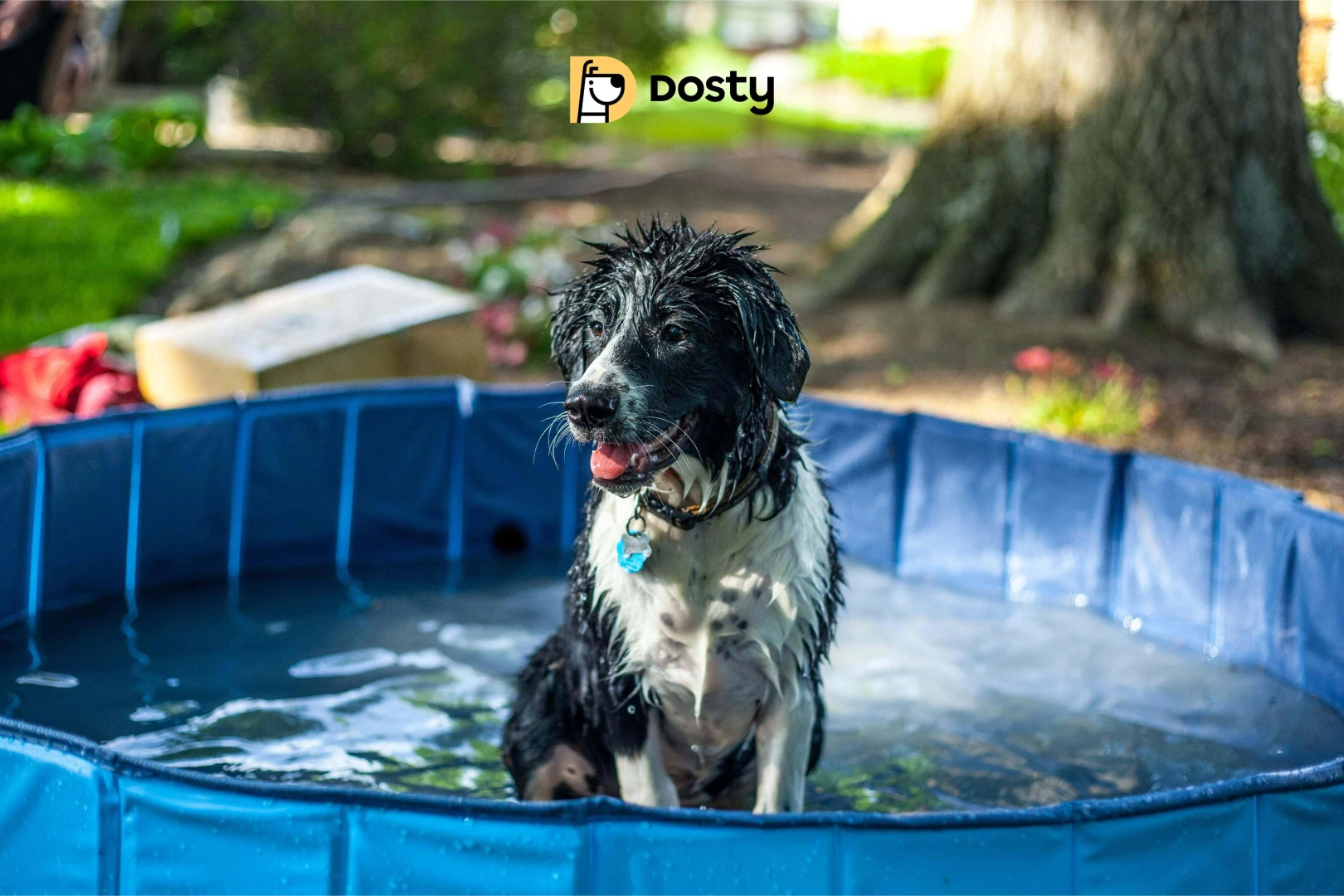On this page
How to Set Up Dog Pool in Backyard
A dog pool is an awesome addition to your backyard, coming with numerous health benefits for your dog, cooling it off in hot weather, and offering a stress-free way of exercising. Whether your dog is full of life or getting up there, having access to water can substantially decrease risk of overheating, obesity, and boredom-related behaviors. Dr. Hunter Finn says water play in dogs with joint problems can also boost your dog’s mobility.
Here’s everything you need to know about selecting the right dog pool, where to set it up, how to install it without worry, and what to do about pool chemicals. Each category is centered on actual veterinary advice and user-centric experiences.
Building a backyard pool for your dog❓
Get Dosty App to:
✔ Count off swim days and vet visits
✔ Get health alerts based on your symptoms
✔ Talk to a pet assistant designed by chatbots
✔ Get things done on time with the help of daily reminders - all in one place
🐶 Download now and ensure every splash becomes safe and smart.
What Type of Dog Pool Is Best for Backyards?
The best dog pool for your backyard is one that’s fit for your dog’s habits, size, and available space. Hard plastic pools also work well for dogs that dig or chew. Inflatable pools are cheap, but they’re delicate. In-ground pools are designed to last forever and provide a custom fit, but they are expensive.
If your dog is a natural swimmer or is prone to overheating due to their breed, such as a Golden Retriever or Bulldog, you may want to consider a more robust pool with built-in shade. Collapsible models are better suited for occasional play, and should be used under supervision.
“A pool is only as great as your dog feels in it. Size, shape and stability are more important than appearance.” – Dr. Lisa Lippman, DVM.
Hard Plastic vs. Inflatable vs. In-Ground Pools
Here’s how the most common kinds of dog pools stack up:
- Hard plastic: hard, tough, resistant, durable, good for heavy use.
- Inflatable: Portable and inexpensive to store.
- In-Ground: A permanent and costly system that is suitable for multi-dog households.
Explore blogs, breed insights, and expert advice on Dosty.co!
How to Choose the Right Size for Your Dog Pool?
The perfect doggie pool size should keep your dog standing, sitting, and turning around with ease. Small breeds, like Boston Terriers, require pools of 32–40 inches, and for large breeds, like Labradors, most temperatures 60+ inches.
Dodge the deep end. Otherwise, dogs should not be submerged up to their shoulders. Please measure your dogs carefully and select according to the measurements.
How Much Does a Dog Pool Cost?
Dog pool prices vary from $25 to $4,500+ depending on the design, materials, and installation.
For quick decision-making:
- Inflatable/foldable pools: $25-$60
- Hard plastic pools: $70–$200
- In ground or custom made: $1,200-$4,500+
Optional extras such as ramps, sun shades, or non-slip flooring can increase that price by another $50–$200. Don't forget water and cleaning materials.
Step-by-Step Guide to Setting Up a Dog Pool
Here's how to do it right to keep your dog safe and healthy in his new doggy pool. Do this in an organised manner:
1. Pick a Location
Select a flat location that has partial shade. Staying away from tree roots, ant hills and steep slopes. Proximity to a hose is ideal.
2. Prepare the Ground
Clear rocks and debris. Fill the area to be leveled with top soil or paving sand. A flat bottom prevents wobbling and sink out of leveling.
3. Add a Mat or Base Layer
Put beneath the pool a thick mat, or foam cushion. This helps you avoid slipping and provides insulation against hot concrete.
4. Set Up the Pool
Read the manufacturer’s directions. Fasten seams, valves, and corners. Leak testing of balloon models is one other best practice.
5. Fill With Clean Water
Use filtered hose water. A medium dog should be filled at, or below, the 10-12 inch mark. Manage depth by breed and temperament.
6. Add Comfort Features
Add a ramp for easy entry. Bring a pop-up canopy or umbrella to provide shade. Set up a water bowl close by, to prevent pool drinking.
7. Oversee it and Introduce Slowly
Allow your dog to get used to the idea of a pool without water. Add toys and praise. Encourage voluntary entry. Never force them in.
Where to Place the Dog Pool in Your Yard?
Dog pools should be located on level, well-drained ground under a shady area. Do not put them near electrical or barbecue source or where runoff can create mud, or algae buildup.
Some of the best backyard spots are grassy patches by fences (providing a break from the wind), or patio corners that get some afternoon shade. Don’t choose areas with lots of trees that shed sap or leaves.
Do You Need a Mat or Shade for Dog Pool Comfort and Safety?
Both mats and shade offer crucial protection. Mats prevent injuries by providing traction and support to joints. Shade will help your dog maintain a normal core body temperature and will reduce the risk of sunburn, particularly in white and thin-coated dogs.
Safety Tips for Using a Dog Pool in the Backyard
The safety is for the most part provided by inspection, regular maintenance and temperature regulation. Dogs can overheat, slip or drink contaminated water if left alone.
Veterinarians suggest keeping swim times less than 30 minutes in hot weather. After use, always make sure to the dry ears and paws. Change the water every 1–2 days to prevent algae or mosquito eggs. Brush out the bottom of the pool at least once a week with a soft brush.
Look out for signs of overheating:
- Excessive panting.
- Glazed eyes.
- Reluctance to move.
These are significant and require cooling and vet care asap.
Should You Use Pool Chemicals or Not?
Dog pools do not recommend the traditional pool chemicals to the dog pool. And those chemicals can irritate the skin, hurt the cornea and cause digestive-tract upset if ingested.
Dogs frequently lick their coats after swimming. This can make even small amounts of chlorine dangerous. Drinking the treated water particularly if the dog laps it from the pool may result in diarrhea and vomiting, or longer term inflammation.
Rather, use clean tap water and replace it occasionally. For multi-dog homes or frequent use, veterinarians may authorize the use of puppy-safe, enzyme-based water treatments. They should be unscented and should have no ammonia derivatives or stabilizers typically found in a human pool.
Be sure to always check with your vet before giving your dog’s water any kind of product. Dr. Stevie Aitken, DVM, notes that “A clean, chemical-free water is better than gold. What’s in the pool is key to hassle-free swimming.”
FAQs About Dog Pools and Backyard Setup
1. Can puppies use dog pools?
Yes, but only in shallow water and with constant supervision.
2. How often should the pool water be changed?
Every 1–2 days. Daily, if soiled.
3. Are ramps necessary?
Yes, for seniors or dogs with short legs. They alleviate back and joint strain.
4. Can dogs share a pool with humans?
Not if chemicals are used. Always keep dog pools and those used by humans separate.
Conclusion – Give Your Dog a Safe and Fun Backyard Pool Experience
A well-configured pooch pool offers not only playtime, but also a legitimate health benefit to your furry friend. When accompanied by the appropriate materials, water care and safety features, it is an asset to your backyard.
Final Checklist:
Choose durable materials.
Choose the right-sized play yard for your breed and temperament.
Skip harsh chemicals.
Use mats, ramps, and shade.
Always supervise.
👉 Establish a safe backyard pool and monitor your dog’s health with Dosty App.


